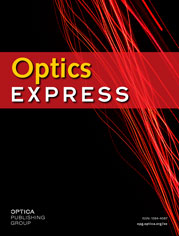Optics Express Feature Announcement
Synergy of Structured Light and Structured Materials
Submission Opens:1 February 2017
Submission Deadline: 1 March 2017
This special issue focuses on the state-of-the-art fundamental research and emerging technologies and applications enabled by the interplay of "structured light" and "structured materials". The synergy between these two areas of modern optics opens entirely new perspectives for fundamental and applied science.
Structured light beams, including optical vortices, vector beams, and nondiffracting beams, possess various unique properties. For example, optical vortices are associated by an annular intensity profile, a helical wavefront, and an orbital angular momentum. Tightly focused radially-polarized vector beams with a polarization singularity have been shown to produce a strong longitudinal electric field along the propagation direction, yielding a smaller far-field spot beyond the diffraction limit. Another class of peculiar structured light beams includes Bessel beams that are nondiffracting and self-healing, i.e. they maintain a narrow beam width over a long propagation distance and can reconstruct themselves behind obstacles in the course of their propagation. Finally, Airy beams and more generally accelerating beams constitute another family of beams that possess quasi-nondiffracting behavior. Structured light beams recently attracted significant attention in a variety of fields, such as optical trapping and manipulations, optical tweezers, sensing, space-division multiplexing optical telecommunications, nonlinear interactions, quantum physics, and 'super resolution' microscopy with a spatial resolution beyond the diffraction limit.
Going beyond foundational work on computer generated holography and diffractive optics, matter may now be designed and fabricated with subwavelength structures (e.g., metamaterials, metasurfaces) to transform optical fields. Conversely, structured optical fields may interact with matter structured on the subwavelength scale to yield new effects, e.g., spin-orbital momentum coupling or unconventional optomechanical effects for advanced optical manipulation. Furthermore, in recent years several demonstrations of structured light-matter interactions enabling the formation of various material structures, including chiral structures and laser-induced periodic surface structures, have been reported. Such advances in structured light transformation and generation enable miniaturized and multi-functional (i.e. shaping wavefront, polarization state, etc.) optical components integrated on a chip.
Topics of interest include, but are not limited to:
- Fundamental properties of structured light and structured materials
- Structured light in engineered media
- Structured light enabled nanostructures
- Metasurfaces and metamaterials for structured light generation, manipulation, and detection
- Fiber for structured light transmission
- Phase singularity and polarization singularity
- Nonlinear singular optics
- Spin-orbit coupling
- Trapping, manipulation, tweezers, sensing, communications, quantum entanglement, and microscopy
All papers need to present original, previously unpublished work, and will be subject to the normal standards and peer-review process of the journals. The standard Optics Express publication charges will apply to all published articles.
Manuscripts must be prepared according to the usual standards for submission to Optics Express and must be uploaded through OSA's electronic submission system, specifying from the drop-down menu that the manuscript is for the Feature Issue on Synergy of Structured Light and Structured Materials.
Feature Issue Editors
Etienne Brasselet, Université de Bordeaux, France
Natalia Litchinitser, University at Buffalo, USA
Ryuji Morita, Hokkaido University, Japan
Takashige Omatsu, Chiba University, Japan
Jian Wang, Huazhong University of Science and Technology, China

